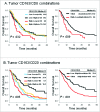The tumoral and stromal immune microenvironment in malignant pleural mesothelioma: A comprehensive analysis reveals prognostic immune markers
- PMID: 26155428
- PMCID: PMC4485766
- DOI: 10.1080/2162402X.2015.1009285
The tumoral and stromal immune microenvironment in malignant pleural mesothelioma: A comprehensive analysis reveals prognostic immune markers
Abstract
Antitumor immune responses against solid malignancies correlate with improved patient survival. We conducted a comprehensive investigation of immune responses in tumor and tumor-associated stroma in epithelioid malignant pleural mesothelioma with the goal of characterizing the tumor immune microenvironment and identifying prognostic immune markers. We investigated 8 types of tumor-infiltrating immune cells within the tumor nest and tumor-associated stroma, as well as tumor expression of 5 cytokine/chemokine receptors in 230 patients. According to univariate analyses, high densities of tumoral CD4- and CD20-expressing lymphocytes were associated with better outcomes. High expression of tumor interleukin-7 (IL-7) receptor was associated with worse outcomes. According to multivariate analyses, stage and tumoral CD20 detection were independently associated with survival. Analysis of single immune cell infiltration for CD163+ tumor-associated macrophages did not correlate with survival. However, analysis of immunologically relevant cell combinations identified that: (1) high CD163+ tumor-associated macrophages and low CD8+ lymphocyte infiltration had worse prognosis than other groups and (2) low CD163+ tumor associated macrophages and high CD20+ lymphocyte infiltration had better prognosis than other groups. Multivariate analyses demonstrated that CD163/CD8 and CD163/CD20 were independent prognostic factors of survival. With a recent increase in immunotherapy investigations and clinical trials for malignant pleural mesothelioma patients, our observations that CD20+ B lymphocytes and tumor-associated macrophages are prognostic markers provide important information about the tumor microenvironment of malignant pleural mesothelioma.
Keywords: B lymphocyte; CI, confidence interval; FoxP3, forkhead box P3; HR, hazard ratio; IL-7R, interleukin-7 receptor; MDSCs, myeloid-derived suppressor cells; MPM, malignant pleural mesothelioma; OS, overall survival; T lymphocytes; TAMs, tumor-associated macrophages; TILs, tumor-infiltrating lymphocytes; Tregs, regulatory T cells; immune responses to cancer; pleural malignancy; tumor-infiltrating lymphocytes.
Figures


References
-
- Robinson BW, Musk AW, Lake RA. Malignant mesothelioma. Lancet 2005; 366: 397–408; PMID:; http://dx.doi.org/10.1016/S0140-6736(05)67025-0 - DOI - PubMed
-
- Krug LM, Pass HI, Rusch VW, Kindler HL, Sugarbaker DJ, Rosenzweig KE, Flores R, Friedberg JS, Pisters K, Monberg M, et al.. Multicenter phase II trial of neoadjuvant pemetrexed plus cisplatin followed by extrapleural pneumonectomy and radiation for malignant pleural mesothelioma. J Clin Oncol 2009; 27: 3007–13; PMID:; http://dx.doi.org/10.1200/JCO.2008.20.3943 - DOI - PMC - PubMed
-
- Flores RM, Krug LM, Rosenzweig KE, Venkatraman E, Vincent A, Heelan R, Akhurst T, Rusch VW. Induction chemotherapy, extrapleural pneumonectomy, and postoperative high-dose radiotherapy for locally advanced malignant pleural mesothelioma: a phase II trial. J Thorac Oncol 2006; 1: 289–95; PMID:; http://dx.doi.org/10.1097/01243894-200605000-00004 - DOI - PubMed
-
- Anraku M, Cunningham KS, Yun Z, Tsao MS, Zhang L, Keshavjee S, Johnston MR, de Perrot M. Impact of tumor-infiltrating T cells on survival in patients with malignant pleural mesothelioma. J Thorac Cardiovasc Surg 2008; 135: 823–9; PMID:; http://dx.doi.org/10.1016/j.jtcvs.2007.10.026 - DOI - PubMed
-
- Yamada N, Oizumi S, Kikuchi E, Shinagawa N, Konishi-Sakakibara J, Ishimine A, Aoe K, Gemba K, Kishimoto T, Torigoe T, et al.. CD8+ tumor-infiltrating lymphocytes predict favorable prognosis in malignant pleural mesothelioma after resection. Cancer Immunol Immunother 2010; 59: 1543–9; PMID:; http://dx.doi.org/10.1007/s00262-010-0881-6 - DOI - PMC - PubMed
Publication types
Grants and funding
LinkOut - more resources
Full Text Sources
Research Materials
